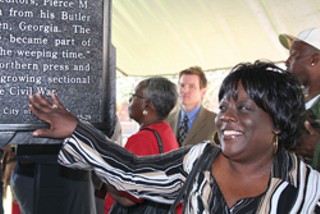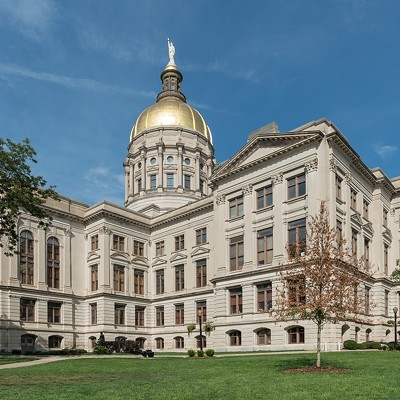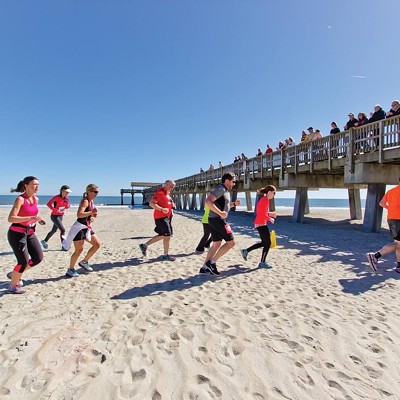THE 'WEEPING TIME' had come and gone. This day was a time for celebration.
On March 3, the City of Savannah and the Georgia Historical Society held a dedication ceremony for a new historical marker at the intersection of Augusta Avenue and Dunn Street. It commemorates one of the nation’s largest slave sales, known as "The Weeping Time," which was held not far from this spot.
On March 2 and 3, 1859, 436 men, women and children from plantations in McIntosh County were brought to Savannah and sold to help settle the debts incurred by their owner, Pierce Butler. That sale left a scar that just wouldn’t heal, and the horrors of that day were never formally recognized.
With the dedication of the marker, many in the crowd felt a wrong finally had been addressed, 149 years after it occurred. Following the dedication, Kwabena Bernard Jones, dressed in African clothing, handed out dirt from Nigeria to be placed in a circle around the new marker.
Water was poured around the marker, as well. “We are commemorating this,” Jones said. “Libation and the soil were something that just came to me.”
The crowd reacted enthusiastically as Mayor Otis Johnson poured the water.
“It is both water and spirit,” Sam Bowers said. “Most definitely spirit.”
“When something this important happens, you have to commemorate it,” Oji Lukata said. “We made the circle all the way back home. The dirt came from Africa -- we came from Africa.”
A small Gullah basket of the kind that has been made in this region for more than 300 years was used to spread the dirt. “The Gullah culture was retained all the way from Africa,” Lukata said. “We are alive and well, in spite of everything.”
During the dedication ceremony, Johnson said the recognition was long overdue. “I am wrestling with a number of emotions,” he said. “Anger, over the inhumanity that took place on this site.
“Hopefully, we will never come to the point where we do not value all human life and classify some people as human and some as chattel,” Johnson said. “And I feel exhilarated because we are here today on this site.”
As a historian, Johnson knows the importance of history. “My undergraduate degree at the University of Georgia is in history with a concentration on American History,” he said. “I’ve always loved knowing about my people. I take great pleasures in trying to educate everyone about the people who built this state and this nation for free.”
Johnson noted that originally, slavery was banned in Georgia, but the colonists found ways to get around the ban. “African Americans need to know and to take great pride that it was our labor in addition to the immigrants from Europe that made Savannah one of the original colonies,” Johnson said.
Savannah was literally carved out of a virgin forest, Johnson said. “Who did that? Our ancestors did,” he said.
Recently, Johnson met one of the descendants of the slaves who were sold at the slave sale. “She talked about how it tore up the family,” he said.
“The slaves were housed in the stalls where they kept horses,” Johnson said. “It was cold and rainy. Some of them got sick and probably some eventually died from the experience.”
At that time, the slaves couldn’t imagine a time when an African American could live in freedom. “I’m very proud to be a black man, an African American,” Johnson said. “But more importantly, I’m proud to be here as the mayor.
“If you think about what happened here in 1859, I don’t think they could even begin to dream that someday people would be here to remember them,” he said. “We’ve come a very long way.
“But on some issues, we haven’t come very far,” Johnson said. “Race still remains a factor in all decisions made in this country. We’re a long way from the Weeping Time, but we have a long way to go.”
Retired professor Martha Keber has been credited with much of the work done to obtain the marker. “This historic marker dedicated today commemorates the largest sale of African Americans in the state of Georgia and one of the largest in the United States,” Keber said.
“The text engraved in bronze tells the story of 436 men, women, children and infants who were taken from their homes on Butler and St. Simons islands so that their owner, Pierce M. Butler, could settle his debts,” she said. “There are names of real people included in that number. They had life experiences, hopes and dreams, that can’t be counted in that number.
“Loden spent most of his 54 years picking cotton with his wife, Hagar,” Keber said. “They had two sons, Little Loden and Silas, and a daughter, Leticia. Their 18-year-old daughter, Rena, had a 1-year-old daughter named Lena. Even the elderly midwife, Violet, was sold here.
“They were separated from friends and family,” Keber said. “They were removed from the only home they ever knew.
“These people were led onto the auction block,” she said. “It’s not surprising that this sale became known as ‘The Weeping Time.’
“We know little of what happened to the individuals who were taken away by their new owners,” Weber said. “History has erased it. This marker is here to ensure that the memories of Loden, Rena and Violet live on.”
Todd Groce, executive director of the Georgia Historical Society, said GHS staff members were having an extraordinary week. “We’re starting the week with the dedication of a marker at the site of one of the largest slave sales,” he said.
“At the end of the week, we’re putting up a marker at the site of the lynching of Leo Frank in Marietta,” Groce said. “In 1915-16, he was alleged to have raped and killed one of his employees at a pencil factory.
“This is a powerful week,” he said. “We are telling parts of history a lot of people would prefer we forget. We feel we should always tell the whole story about what happened.
“I got a phone call recently,” Groce said. “Someone asked me, ‘Why are you doing this? Why are you putting a marker in that neighborhood? All it will do it stir up anger and resentment.’
“The only way we can overcome the tragedy of this event is by being honest with each other,” he said. “The beginning of healing is to recognize this thing and not just ignore it.What we are doing today is being honest about the past.”
The original location of the Ten Broeck racetrack where the sale took place now lies under Interstate 16. Groce said the new park is a very appropriate place to put the marker. “This marker will be read by people who will never read a book or attend a lecture at the Georgia Historical Society,” he said.
Using such large numbers as 436 tends to block out the emotion behind the numbers. “We tend to forget that each number is a person with an individual story,” Groce said. “Their lives were completely altered in a tragic way.”
Nearly 140 historical markers have been placed throughout Georgia under GHS guidance. “One of the best things about this is that more than a quarter of the historic markers have been dedicated in areas that history tends to ignore,” Groce said.
Today, suggestions for the placement of markers are accepted from the general public. “It’s been good for the state,” Groce said. “It allows us to reach out and tell a story like this.”
Even today, the effects of slavery linger on. “But there is considerable hope,” Groce said. “Today in this country, we have an African-American who’s running for president.”
Lindsay Mitchell, president of the Bartow Elementary School Student Council and her fellow council members were in attendance to represent the future of African Americans. “The Bartow Student Council is excited at how far we’ve come in our history,” she said. “We want to remember that we are standing on the shoulders of all those who gave their lives so that we could be standing here today.” 
To comment e-mail us at
About the marker
The text of the new marker tells the story of 436 slaves were taken from their homes on Butler and St. Simons islands and sold in Savannah so that their owner, Pierce M. Butler, could settle his debtsRain fell continuously throughout the two-day slave sale that became known as “The Weeping Time,” but stopped soon after the last slave was auctioned. Onlookers said it was almost as if Heaven itself was crying.
Reporters from the North attended the slave auction and their resulting articles further deepened the division between Northermers and Southerners over slavery.
Pierce Butler and his brother, John, had inherited their plantations 20 years earlier, but Pierce had squandered his inheritance, losing a rumored $700,000.
The sale netted Butler more than $300,000, and soon after the auction, he left for a trip to Europe.
Being a slaveholder cost Pierce Butler his marriage to the famous actress, Fanny Kemble, who was so outraged that he owned slaves that she left him. Her diary was used by abolitionists to further denounce slavery.






























